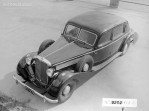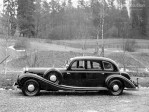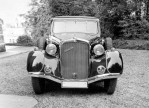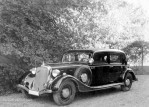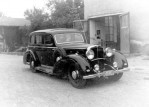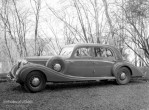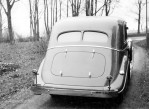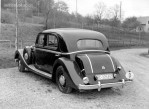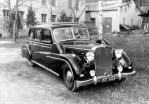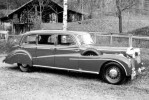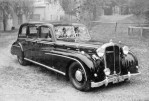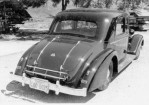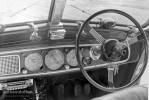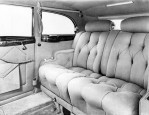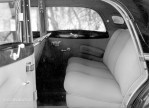Segment: Upper Premium
Production years: 1940, 1941, 1942, 1943, 1944, 1945
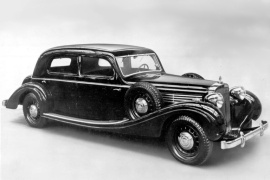 26 Photos
26 PhotosThe Maybach SW series included numerous versions of vehicles, including coupes, convertibles, and limousines. They shared the same chassis, but with different wheelbases. And some were very rare, such as the model 42.
WWII already started in 1939 when the first SW42 rolled out from the factory, but it was the same as before: the chassis was built by Maybach and then the bodywork was supplied by other companies such as Glass, Spohn, or Vysoke Myto in Slovakia. The last vehicle built over an empty SW42 chassis is believed to be the Erdman&Rossi in 1949 for an East Germany official.
The main idea of the time was that a custom-built needs to be done by special workshops and the chassis, drivetrain, and engine to be built by another workshop. From the 133 chassis built by Maybach for the SW42, The main difference between the SW38 and the SW42 was the engine displacement. Due to the shortage of better fuel, which was used by the German Army, the car-manufacturer had to lower the compression ratio up to 6.6:1, instead of the regular 8:1. Due to that, the power output dropped. But Maybach didn't want its cars to be sluggish and slow. With the increase, it obtained the same 140 hp from the straight-six unit. The carburetors were also modified for the lower-quality fuel.
The interior of the Maybach 42, regardless of the bodywork, was built with high-quality materials. An interesting quality of the vehicles, especially for those built by Spohn, was that they featured electrically operated windows.
MAYBACH Typ SW 42 1940, 1941, 1942, 1943, 1944, 1945
- 4.2
- 4.2 Lang
MAYBACH Typ SW 42
4.2
ENGINE SPECS - 4.2 | |
|---|---|
| Cylinders: | L6 |
| Displacement: | 4196 cm3 |
| Power: | 103 KW @ 4000 RPM 140 HP @ 4000 RPM 138 BHP @ 4000 RPM |
| Fuel System: | Carburetors |
| Fuel: | Gasoline |
PERFORMANCE SPECS | |
|---|---|
| Top Speed: | 99 mph (159 km/h) |
TRANSMISSION SPECS | |
|---|---|
| Drive Type: | Rear Wheel Drive |
| Gearbox: | Sequential, 4 Speed |
BRAKES SPECS | |
|---|---|
| Front: | Drums |
| Rear: | Drums |
TIRES SPECS | |
|---|---|
| Tire Size: | 7.50-17 |
DIMENSIONS | |
|---|---|
| Width: | 72.8 in (1849 mm) |
| Front/rear Track: | 56.7/58.3 in (1,440/1,481 mm) |
| Wheelbase: | 133.1 in (3381 mm) |
FUEL ECONOMY (NEDC) | |
|---|---|
| Combined: | 13.1 mpg US (18 L/100Km) |
| CO2 Emissions: | 427 g/km |
MAYBACH Typ SW 42
4.2 Lang
ENGINE SPECS - 4.2 Lang | |
|---|---|
| Cylinders: | L6 |
| Displacement: | 4196 cm3 |
| Power: | 103 KW @ 4000 RPM 140 HP @ 4000 RPM 138 BHP @ 4000 RPM |
| Fuel System: | Carburetors |
| Fuel: | Gasoline |
PERFORMANCE SPECS | |
|---|---|
| Top Speed: | 99 mph (159 km/h) |
TRANSMISSION SPECS | |
|---|---|
| Drive Type: | Rear Wheel Drive |
| Gearbox: | Sequential, 4 Speed |
BRAKES SPECS | |
|---|---|
| Front: | Drums |
| Rear: | Drums |
TIRES SPECS | |
|---|---|
| Tire Size: | 7.50-17 |
DIMENSIONS | |
|---|---|
| Width: | 72.8 in (1849 mm) |
| Front/rear Track: | 56.7/58.3 in (1,440/1,481 mm) |
| Wheelbase: | 144.9 in (3680 mm) |
FUEL ECONOMY (NEDC) | |
|---|---|
| Combined: | 13.1 mpg US (18 L/100Km) |
| CO2 Emissions: | 427 g/km |



